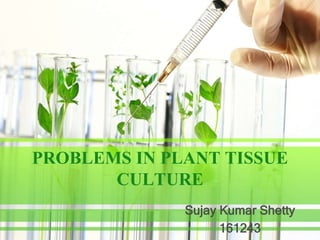
Problems in plant tissue culture
- 1. PROBLEMS IN PLANT TISSUE CULTURE Sujay Kumar Shetty 161243
- 2. Different problems in Plant tissue culture • 1. Recalcitrance • 2. Contamination • 3. Phenolic browning • 4. Seasonal variation • 5. Vitrification( hyperhydricity) • 6. Somaclonal Variation
- 3. 1.Recalcitrance • Recalcitrance reffers to inability of plant tissue culture to respond to culture manipulation.(loss of morphogenetic competence and totipotency capacity.) • Free radicals have an important role in the metabolism and development of aerobic organisms.
- 4. • free radical-mediated stress has a role in tissue culture recalcitrance. • In vitro plant systems have shown that tissue cultures produce free radicals, lipid peroxides and toxic, aldehydic lipid peroxidation products. • antioxidant protection is compromised oxidative stress ensues and free radicals and their reaction products react with macromolecules such as DNA, proteins and enzymes, causing cellular dysfuction and, as a result, the cultures become recalcitrant.
- 5. • All aerobic organisms are totally dependent upon redox reactions and the transfer of single electrons and many life processes involve free radical intermediates. • Free radicals and their reaction products have an important role in plant stress (Hendry and Crawford, 1994) and senescence.
- 6. How to overcome ? • Juvenile tissue can be selected as explant • Parts of the desired plant rejuvinated by treatments like cytokinine spray on selected branches
- 7. 2.Contamination • Bacteria, fungi, moulds and yeasts are common contaminating microorganisms in tissue culture. • In plants they occur as microflora associated with roots (rhizosphere and rhizoplane) leaves (phyllosphere and phylloplane), other plant parts and subliminally as endophytes in plant tissues and vegetative propagules.
- 8. • Contamination in tissue culture can originate from two sources, either through carry over of microorganisms on the surface or in the tissues of explants, or through faulty procedures in the laboratory. • Many of the microorganisms that are likely to be present intercellular, in plant tissues will be capable of growth on the plant tissue culture medium, although some may be inhibited by the high salt or sucrose concentration and the pH (Cassells et aI., 1988).
- 9. How to overcome? • Wear gloves and a lab coat and keep long hair tied back. • Work in a laminar flow hood when passaging cells. • Wipe down working surfaces with ethanol. • Use sterile equipment.
- 10. • Stay as organized as possible—label everything and set up all of your materials before getting started. • Inspect all equipment and media for visible contamination before use. • If you must completely remove a lid from a tube, plate or bottle, set it down within the hood with the open surface facing up. Otherwise, keep tubes, plates or bottles closed as much as possible.
- 11. • Do not pass your hands/arms over any open bottle, plate or tube. • Use proper antibiotics in your culture media. • When finished, dispose of materials properly, wipe down working surfaces with ethanol, and turn on UV lamp within laminar flow hood for 10 minutes to sterilize the area.
- 14. 3.Phenolic Browning • Many plants are naturally rich in polyphenolic compounds that are commonly regarded as inhibitory agents. In most of the cases, when these plants are cultured in vitro, the culture medium turns brown. • Phenolic browning caused by the accumulation and oxidation of phenolic compounds. • Addition of antioxidants to medium was more effective to reduce the browning.
- 15. • preventative approach is inhibiting the activity of the phenylalanine ammonia lyase enzyme (PAL), thereby reducing the biosynthesis of phenolic compounds.
- 16. How to overcome? • Culture Bottles are kept in dark condition • Activated charcoal used in media • Use of antioxidant mixture( Ascorbic acid 0.1gm/ltr+ Citric acid0.15gm/ltr) • Polyvinylpyrrolidone, PVP-40 acts as a antioxidant
- 19. 4. Seasonal Variation • In Invitro culture seasonal variation is also effected such as relative humidity, Dry season. • When too dry nutrient medium evaporates rapidly. • In extream moist climate such as poor tropical region fungi is effected on media • Dust in air is also a major source of bacterial contaminants. • Small insects insects that enter incubation room through undetermined avenues is also effects the culture tube.
- 20. • Germination of shoots and roots also delayed due to the seasonal variation.
- 21. 4. Vitrification • Hyperhydricity is the physiological malformation due to excessive hydration, low lignification and reduced mechanical strength of tissue culture generated plants. • hyperhydricity in plant tissue cultures are those factors triggering oxidative stresses such as high salt concentration, high relative humidity, low light intensity, gas accumulation in the atmosphere of the jar, length of time intervals between subcultures.
- 22. • High ammonium concentration also contributes to hyperhydricity. • The reasons include low calcium content in culture medium, gas builtup within the container, High concentrations of salts in culture medium, low light intensity among others. • Vetrification is also seen in culture bottles kept in same container.
- 23. Hyperhydrisity
- 24. Overcome of Vitrification • Culture bottles are subcultured frequently to overcome this vitrification.
- 25. 5. Somaclonal Variation • Phenotypic change • It Occurs due to change in chromosome number and/or structure – Genetic heterogeneity • Most of the somaclonal variations are not useful. • Variations are unpredictabled and uncontrolled • They are not stable and heritable • Cultiver dependent
- 26. • Many cell lines cannot exhibit regeneration potentia. Overcome of Somaclonal Variation • Avoiding long term term cultures • Axillary shoot induction systems • Regularly reinitiating clones from new explants. • Prevent usage of 2-4D IN media
- 27. Refference: • Chaudhury, A. M., S. Letham, S. Craig and E. S. Dennis (1993). Amp1-a mutant with high cytokinin levels and altered embryonic pattern, faster vegetative growth, constitutive photomorphogenesis and precocious flowering. Plant J. 4:907-916. • Lin FL, Sperle K, Sternerg N, Model for • homologus recombination during transfer of DNA into mouse L cells: ends in the recombination process plant biotechnology